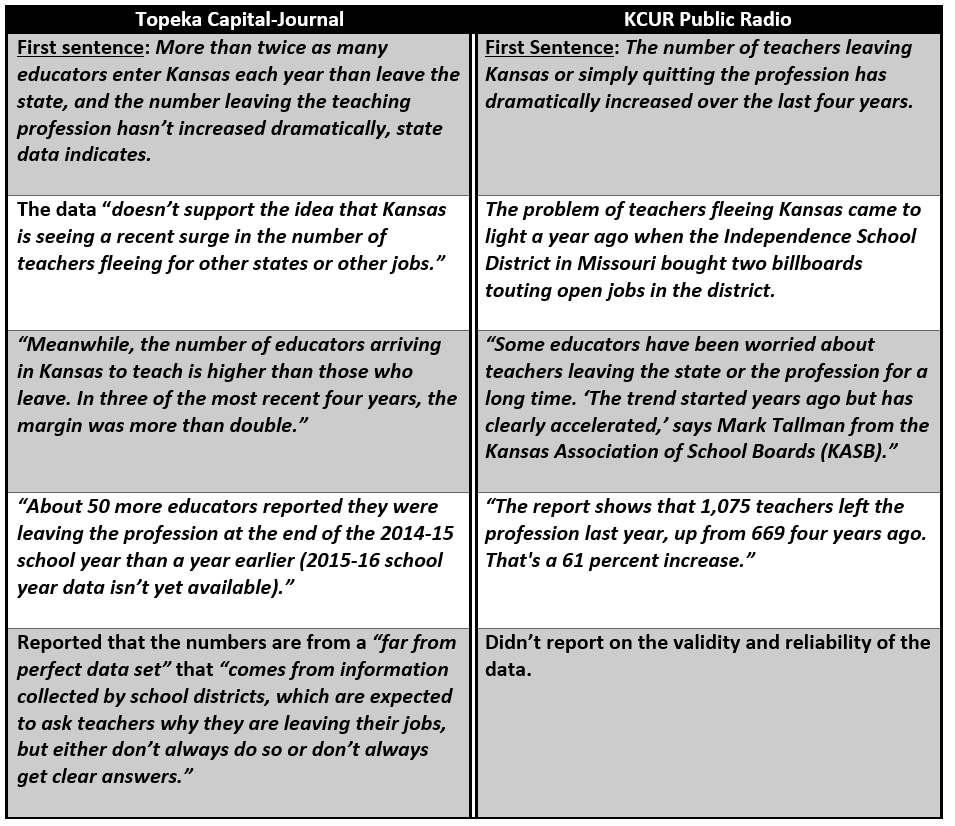Does data that describes those who leave teaching in Kansas support the conclusion that the numbers have “dramatically increased” or does it indicate that those leaving the profession “hasn’t increased dramatically”? As backwards as this sounds, I guess it depends on whether you harbor a pre-determined conclusion. I know, I know, you’re supposed to collect and analyze data before you make pass judgment. Unfortunately, that’s not a pattern followed by the news media when it comes to reporting on education in Kansas. But in a true man-bites-dog moment, a mainstream media schism emerged with regards to reporting on Kansas teachers who have in recent years left the profession.
At the August State Board of Education meeting, KSDE presented the annual report on licensed teaching personnel in Kansas. (The report hasn’t been formally released as of this writing.) Two media outlets, the Topeka Capital-Journal and KCUR public radio received the same data but reported it in astonishingly different ways. Here’s a side-by-side comparison of the two articles.
 It makes you wonder if they attended the same meeting.
It makes you wonder if they attended the same meeting.
But give credit where credit is due. Celia Llopis-Jensen, who wrote the Capital-Journal piece could have followed the established media narrative and reported the data the same way KCUR’s Sam Zeff did. But she didn’t and kudos to her. Her line that teacher exiting numbers come from a “far from perfect data set” is spot-on. I’m living proof of that. When I resigned from USD 501 in 2014 no one asked why I was quitting and I didn’t tell them I was going to work for KPI. The personnel report that was given to the 501 school board listed my resignation reason as “personal reasons.” Furthermore, a teacher colleague of mine recently resigned because her husband (not a teacher) wanted to move out of state. The personnel report also listed hers as “personal reasons.” In other words, two people who quit teaching in Kansas for very different reasons were lumped together in the same separation category. And I’m sure our situations are not unique.
Conversely, Zeff misused the data to support his pre-determined conclusion. Here’s what I mean. Suppose you were asked to analyze the Kansas City Royals performance in 2016. If you haven’t been paying attention, the Royals have been about a .500 team this season. So, let’s say the Royals end up winning 81 games. You decide to go back five years and compare the 2016 team to the 2011 Royals, when they won 71 games. That’s a 14% increase. Pretty good, eh? Well, until you’re reminded that the Royals have gone to the World Series the last two years, winning it in 2015. This scenario is analogous to what Zeff did when describing Kansas teachers leaving for Missouri. He reports that the number of Kansas teachers seeking licenses in Missouri has “doubled since 2011.” What he fails to mention is, according to Missouri Department of Education data, the 2016 number (122) is much lower that it was three of the last four years. I wouldn’t exactly call that “fleeing,” as Zeff describes it.

The truth is, there’s no perfect system for reporting why teachers (or people in other occupations, for that matter) leave the profession. Furthermore, there’s no need for one. Kansas is just like most other states across the country that are experiencing teacher shortages. (There have been 135 articles written on the subject so far this year in Education Week alone.)The sudden interest stems from the false narrative that Kansas is uniquely experiencing a teacher shortage, and it’s due to…what else? Underfunding by the Legislature (yawn). In this blog I analyzed a similar situation in 2015. There’s no need to rehash it.
The media would better serve Kansas by focusing on the real crisis – unacceptable overall achievement scores, especially the low incomes students who lag 2-3 years behind their peers.
I applaud Ms. Llopis-Jepson and the Capital-Journal for having the chutzpah to defy the current narrative. Sam Zeff could learn something from her.




